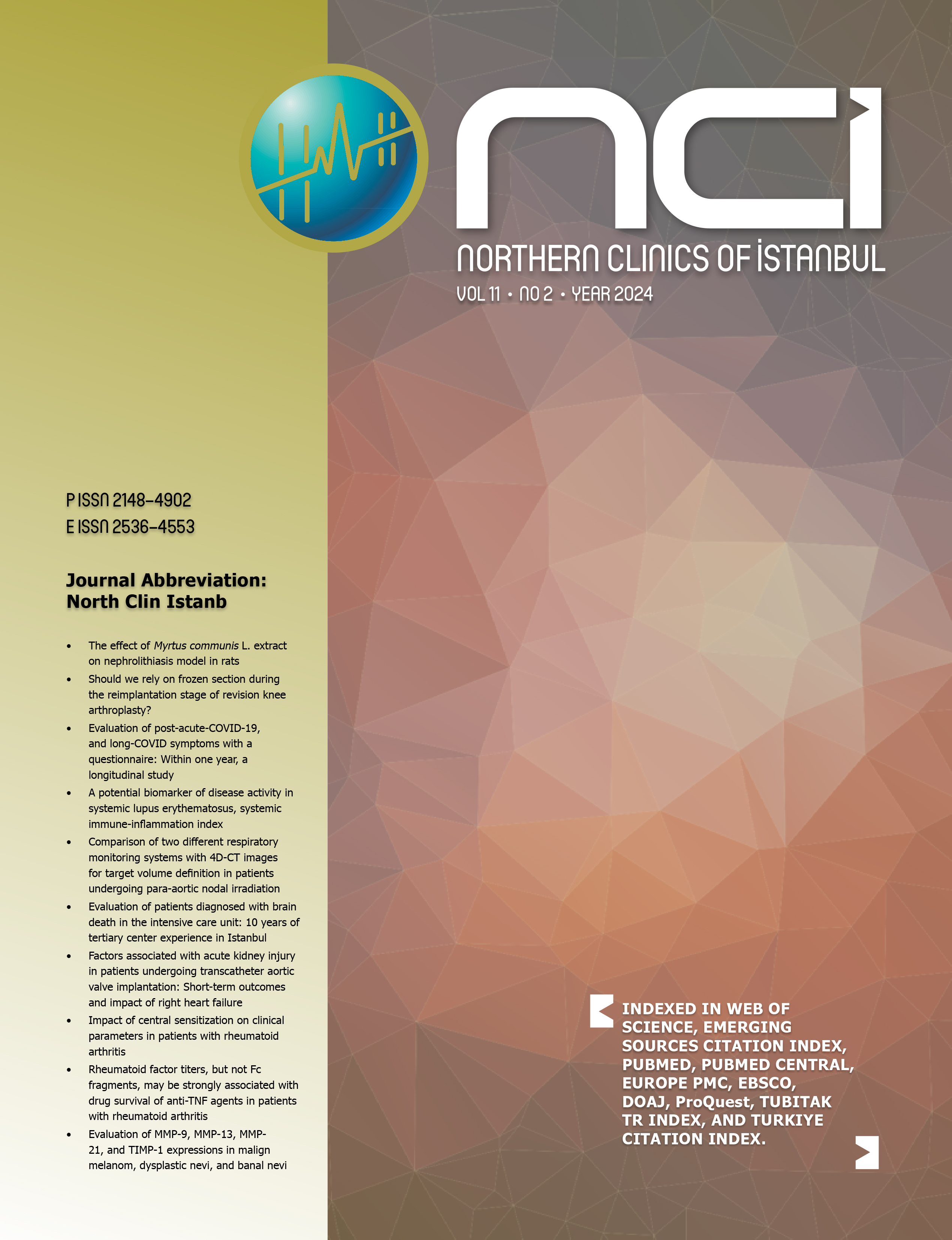Efficacy and safety of diuretic infusion in saline for percutaneous nephrostomy in non-dilated renal collecting systems: A single-center experience
Ali Dablan, Omer Altun, Fatma Zeynep Arslan, Cagri Erdim, Ilhan Nahit Mutlu, Ozgur KilickesmezDepartment of Radiology, Basaksehir Cam and Sakura City Hospital, Istanbul, TurkiyeOBJECTIVE: In this retrospective study, we aimed to investigate the etiology, success, and complication rate of percutaneous nephrostomy (PCN) in patients with non-dilated renal collecting system (NCT) using saline and diuretic agents.
METHODS: PCN was performed on 62 kidneys from 35 patients with NCT. Prior to the procedure, a combination of saline and furosemide infusion was administered. Several parameters were evaluated, including pre- and post-procedure levels of creatinine and blood urea nitrogen, fluoroscopy time, total air kerma (TAK), dose area product (DAP), puncture number, success rate, and complication rate.
RESULTS: Fistula was the most common etiology and was detected in 29 out of 62 kidneys. The other most common cause was ureteral injury, detected in 21 out of 62 kidneys. The success rate of our procedures was 96.7%, and the rate of minor complications was 1.7%. Transient macroscopic hematuria was one of the minor complications observed in one patient. No major complications were observed. During each procedure, the average number of needle passes was 1.44±0.5 (range: 13). The average duration of the complete procedure was 13.17±6.46 minutes (range: 831 minutes). The mean fluoroscopy time was 2.37 minutes (range: 0.811.6 minutes). In terms of radiation exposure, the mean DAP was 166.94±148.5 μGy·m² (range: 3.93666.59 μGy·m²) with a median of 127.04 μGy·m², and the cumulative dose (TAK) was 72.43 mGy (range: 12342 mGy) with a median of 42.05 mGy, respectively.
CONCLUSION: Diuretic infusion in saline is a safe and beneficial method for PCN in NCT. With its low complication rate and high success rate, PCN provides rapid treatment for various etiologies with the potential to address conditions such as fistula, ureteral injury, and urosepsis in the collecting system, which may otherwise have devastating consequences.
Keywords: Furosemide; nondilated pelvicalyceal system; non-obstructive uropathy; percutaneous nephrostomy; urine leaks.
Dilate olmayan renal toplayıcı sistemlerde perkütan nefrostomi için salin içinde diüretik infüzyonunun etkinliği ve güvenliği: Tek merkez deneyimi
Ali Dablan, Omer Altun, Fatma Zeynep Arslan, Cagri Erdim, Ilhan Nahit Mutlu, Ozgur KilickesmezBaşakşehir Cam ve Sakura Şehir Hastanesi, Radyoloji Kliniği, İstanbulAmaç: Bu retrospektif çalışmada, dilate olmayan böbrek toplayıcı sisteminde salin ve diüretik infüzyonu sonrasında perkütan nefrostomi (PKN) işleminin etkinliğini ve güvenilirliğini ortaya koymayı amaçladık.
Metod: Genişlememiş renal toplayıcı sistemi olan 35 hastanın 62 böbreğine salin ve furosemid infüzyonu sonrasında PKN işlemi uygulandı. İşlem öncesi ve sonrası kreatinin ve üre seviyeleri, floroskopi süresi, toplam hava kerma (THK), doz alan çarpımı (DAÇ), ponksiyon sayısı, başarı oranı ve komplikasyon oranı dahil olmak üzere çeşitli parametreler değerlendirildi.
Sonuçlar: En sık etiyolojik neden fistül olup 62 böbreğin 29'unda saptandı. Diğer en sık neden üreter yaralanmasıydı ve 62 böbreğin 21'inde saptandı. İşlemlerimizin başarı oranı %96,7 olarak ölçülürken; minör komplikasyonlar %1,7 olarak hesaplandı. Bir hastamızda minör komplikasyon olarak geçici makroskopik hematüri gelişti. Hiçbir majör komplikasyon gözlenmedi. Her prosedür sırasında ortalama iğne geçiş sayısı 1,44±0,5 (aralık: 13) idi. Tüm prosedürün ortalama süresi 13,17±6,46 dakikaydı (aralık: 831 dakika). Ortalama floroskopi süresi 2,37 dakikaydı (aralık: 0,811,6 dakika). Radyasyona maruz kalma açısından, ortalama doz alan çarpanı (DAÇ) 166,94±148,5 μGy·m² (aralık: 3,93666,59 μGy·m²) ve medyan 127,04 μGy·m²; kümülatif doz (toplam hava kerma) ise 72,43 mGy (aralık: 12342 mGy) ve medyan 42,05 mGy olarak saptanmıştır.
Tartışma: Salin ve diüretik infüzyonu, dilate olmayan pelvikalisiyel sistemlerde PKN için uygulanabilen etkili ve güvenilir bir yöntemdir. Düşük komplikasyon oranı ve yüksek başarı oranı ile PKN, fistül, üreter yaralanması ve ürosepsis gibi çeşitli etiyolojilerin etkin tedavisini sağlamada başarılı sonuçlar ortaya koymaktadır. (NCI-2023-7-7)
Anahtar Kelimeler: Furosemid; non dilate pelvikalisyel sistem; nonobstrüktif üropati; perkütan nefrostomi; idrar kaçağı.
Manuscript Language: English





















